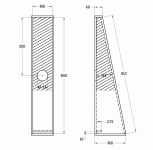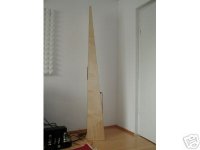Me and my friend are about to build our first pairs of fullrange speakers.
We will use the new Fostex FE166ESR drivers.
A tall tapered nonfolded quarterwave constuction.
I have downloaded the mathcad stuff from:
http://www.quarter-wave.com/
Need some final exact cabinet measurements.
We will also use the suggested Baffle Step Correction Circuit.
To drive the quarterwaves we will use a tubeamp and for the other speakerpair a gaiclone.
Any recomendations, suggestions for improvement is welcome!
We will use the new Fostex FE166ESR drivers.
A tall tapered nonfolded quarterwave constuction.
I have downloaded the mathcad stuff from:
http://www.quarter-wave.com/
Need some final exact cabinet measurements.
We will also use the suggested Baffle Step Correction Circuit.
To drive the quarterwaves we will use a tubeamp and for the other speakerpair a gaiclone.
Any recomendations, suggestions for improvement is welcome!
Attachments
I did some modeling using MJK's mathcad worksheet for this driver, but decided to build the recommended backloaded horn. Check my post in which I summarized the modeling results.
http://www.diyaudio.com/forums/showthread.php?postid=553121#post553121
Note: all the dimensions are internal.
Good luck.
http://www.diyaudio.com/forums/showthread.php?postid=553121#post553121
Note: all the dimensions are internal.
Good luck.
Please elaborate further why you choose the original backloaded horn construction. My friend favours that one, I like the estetics of a tall, slim speaker.
The drivers are recently just ordered so we are in no hurry to build. I will follow the other thread to see what conclusions you guys come up with. The hybrid Karlson/Transmission Line cabinet looks interesting.
Thanks for your reply.
The drivers are recently just ordered so we are in no hurry to build. I will follow the other thread to see what conclusions you guys come up with. The hybrid Karlson/Transmission Line cabinet looks interesting.
Thanks for your reply.
If you decide to go with the TQWP, I suggest you use a round tube port. I put a slot port like that in one of my designs, and it did not behave like I expected. I had to shorten it quite a bit, and it was not easy to do. Tube ports are easier to tune. Just something to think about.
Jeremy
Jeremy
Tachyon said:read somewhere that the size of it should be the same area as the driver, is that correct?
The relatively recent ML-TQWT studies have shown that -- typically -- a port smaller than driver area is best.
Actually driver area does not affect any aspect of the design of a TQWT other than that it is a conveinient fixed parameter. The parameter of interest is the Vas.
dave
What it looked like you were considering building, from the drawing at least, is a mass loaded TQWP. Essentially the air in the port helps to determine the tuning frequency of the enclosure. It's sort of a bass reflex, TQWP hybrid.
I believe the suggestion to make the terminus equal to Sd is from an older "rule of thumb" type approach TQWP design. My first speaker project was like this-and while it sounded quite good, it was far from optimal. I think you can get more predictable, and far flatter response from a mass loaded pipe, like MJK's mathcad worksheets allow you to design.
The way I approach this, is to start by modelling a BR enclosure for the driver I want to use with a program like WinISD (free too!). Then I use the recommended box volume and port geometry as a starting point for a design. I model that as a tall thin tapered pipe in martins ML TQWP, or BR worksheet. Typically, you will need to shorten the port considerably, and play around with Vb. Start with a reasonable line length-usually less than 60". Begin with the speaker at 1/2 of the line length and move it up or down to flatten out some of the ripple caused by the 2nd or 3rd pipe harmonic. If you try to vary only one parameter at a time, then you can get a feel for how different changes affect the response, and zone in on a near optimal design. I like to design with no stuffing, it allows me to see how close I am getting.
Enjoy your speaker project, and keep us posted as to what you decide to do.
Jeremy
I believe the suggestion to make the terminus equal to Sd is from an older "rule of thumb" type approach TQWP design. My first speaker project was like this-and while it sounded quite good, it was far from optimal. I think you can get more predictable, and far flatter response from a mass loaded pipe, like MJK's mathcad worksheets allow you to design.
The way I approach this, is to start by modelling a BR enclosure for the driver I want to use with a program like WinISD (free too!). Then I use the recommended box volume and port geometry as a starting point for a design. I model that as a tall thin tapered pipe in martins ML TQWP, or BR worksheet. Typically, you will need to shorten the port considerably, and play around with Vb. Start with a reasonable line length-usually less than 60". Begin with the speaker at 1/2 of the line length and move it up or down to flatten out some of the ripple caused by the 2nd or 3rd pipe harmonic. If you try to vary only one parameter at a time, then you can get a feel for how different changes affect the response, and zone in on a near optimal design. I like to design with no stuffing, it allows me to see how close I am getting.
Enjoy your speaker project, and keep us posted as to what you decide to do.
Jeremy
Tachyon said:Thanks for the tip on the port,
read somewhere that the size of it should be the same area as the driver, is that correct?
If we do the a TQWT it will be with a pointed top.
FYI, it's no R-O-T, but what is required for peak efficiency at Fb and actually is spelled out in the original bass reflex patent of 1932. What has been learned in recent decades is that you don't necessarily want peak efficiency at Fb.I believe the suggestion to make the terminus equal to Sd is from an older "rule of thumb" type approach TQWP design.
GM
Thanks for all the help guys!
I'm a newbie at speaker construction, so this feedback is highly appreciated. I will download the WinISD and make my virtual model from there. Feels a bit odd to start with a BR construction, but with the port it makes sense. Some of the terminology and parameters that is used is unknown to me.
Hopefully this will become clearer as I move ahead with this project.
Thanks again.
/Ralph
I'm a newbie at speaker construction, so this feedback is highly appreciated. I will download the WinISD and make my virtual model from there. Feels a bit odd to start with a BR construction, but with the port it makes sense. Some of the terminology and parameters that is used is unknown to me.
Hopefully this will become clearer as I move ahead with this project.
Thanks again.
/Ralph
GM said:FYI, it's no R-O-T, but what is required for peak efficiency at Fb and actually is spelled out in the original bass reflex patent of 1932. What has been learned in recent decades is that you don't necessarily want peak efficiency at Fb.
Thanks for the correction. Didn't mean to spread misinmormation.
My bad, didn't read the notes, thanks anyway.
If I get stuck again I'll let you know.
"One final note, the notation used for the Thiele/Small parameters in my MathCad worksheets is a little bit different. When I first started studying speaker design theory, I decided I did not like the subscripts used in the original AES papers so I translated them into my own subscript convention. I changed the "s" subscript to a "d" subscript for all of the variables. This change exists in all of my personal notes and MathCad worksheets created over the past 20 years. At some point I will buckle under and conform to the generally accepted convention, but for right now all I can offer is the following translation. I know that this has caused some confusion for a few people and I appologize for any inconvenience."
If I get stuck again I'll let you know.
"One final note, the notation used for the Thiele/Small parameters in my MathCad worksheets is a little bit different. When I first started studying speaker design theory, I decided I did not like the subscripts used in the original AES papers so I translated them into my own subscript convention. I changed the "s" subscript to a "d" subscript for all of the variables. This change exists in all of my personal notes and MathCad worksheets created over the past 20 years. At some point I will buckle under and conform to the generally accepted convention, but for right now all I can offer is the following translation. I know that this has caused some confusion for a few people and I appologize for any inconvenience."
- Status
- This old topic is closed. If you want to reopen this topic, contact a moderator using the "Report Post" button.
- Home
- Loudspeakers
- Full Range
- TQWP with FE166ESR

